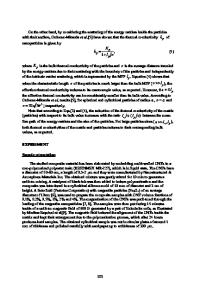Electrospun PU nanofiber composites based on carbon nanotubes decorated with nickel-zinc ferrite particles as an adsorbe
- PDF / 3,357,244 Bytes
- 11 Pages / 595.276 x 790.866 pts Page_size
- 70 Downloads / 251 Views
RESEARCH ARTICLE
Electrospun PU nanofiber composites based on carbon nanotubes decorated with nickel-zinc ferrite particles as an adsorbent for removal of hydrogen sulfide from air Bozorgmehr Maddah 1 & Alireza Yavaripour 1 & Saeed Hasani Ramedani 1 & Hasan Hosseni 1 & Mahdi Hasanzadeh 2 Received: 9 October 2019 / Accepted: 14 May 2020 # Springer-Verlag GmbH Germany, part of Springer Nature 2020
Abstract This study focuses on the synthesis of carbon nanotubes decorated with nickel-zinc ferrites and fabrication of polyurethane (PU) nanofiber containing CNT-ferrite composites as highly efficient adsorbents for removal of hydrogen sulfide. Scanning electron microscopy (SEM), transmission electron microscopy (TEM), Fourier transformed infrared (FTIR) spectroscopy, and powder X-ray diffraction (PXRD) are used to perform microstructural and morphological characterization of the electrospun nanofibrous composites. To show the efficiency of the composite as an adsorbent, a breakthrough test is carried out. It is shown that the PU-CNT-ferrite composites are fabricated almost uniformly with an average fiber diameter of 320 nm and exhibit significant H2S breakthrough capacity (498 mgH2S/ g) compared to both the pristine PU and PU-CNT nanofibers. These electrospun nanofibers based on CNT-ferrite composites, already studied for H2S adsorption with promising results, open up new and interesting perspective into the design and fabrication of highly efficient membrane for practical application in the processes of air purification. Keywords Polyurethane nanofibers . Ferrite . Carbon nanotubes . Hydrogen sulfide . Breakthrough capacity
Introduction Hydrogen sulfide, as toxic gas with corrosive nature, is one of the most common compounds present in fossil fuels and natural gas (Faye et al. 2016; Xue et al. 2003). Owing to its hazard, toxic properties, air pollution, and corrosion of metallic materials, removal of H2S from gas stream is often necessary (Maat et al. 2005; Wang et al. 2008). Despite a lot of commercial treatment techniques used for H2S adsorption, including condensation, chemical oxidation, incineration or catalytic combustion, and wet absorption (Stepova et al. 2009), adsorption processes are still the most attractive techniques, owing to their Responsible Editor: Philippe Garrigues * Bozorgmehr Maddah [email protected] * Mahdi Hasanzadeh [email protected] 1
Department of Chemistry, Imam Hossein University, Tehran, Iran
2
Department of Textile Engineering, Yazd University, P.O. Box 89195-741, Yazd, Iran
simplicity, cost-effectiveness, and high efficiency. Different adsorbents such as activated carbon (Huang et al. 2006; Mochizuki et al. 2016), iron hydroxide (Lee et al. 2019; Magnone et al. 2018), zeolites (Sigot et al. 2016), clay (Stepova et al. 2009), nanoparticles (Daneshyar et al. 2017; Geng et al. 2019), carbon nanotubes (Dong et al. 2019), and graphene (Faye et al. 2018; Kim et al. 2019) have been examined. Since the breakthrough capacity of adsorbents is strongly dependent on their surface com
Data Loading...











